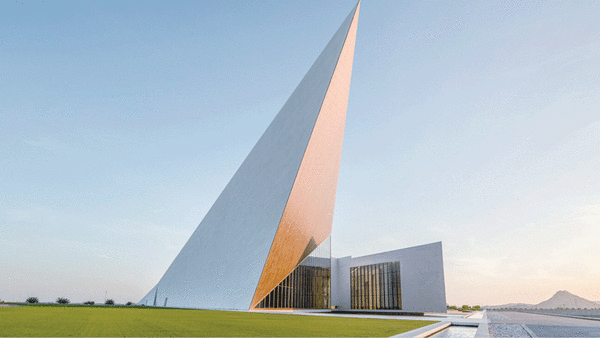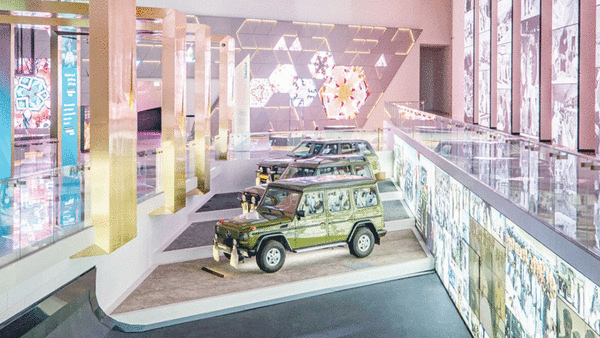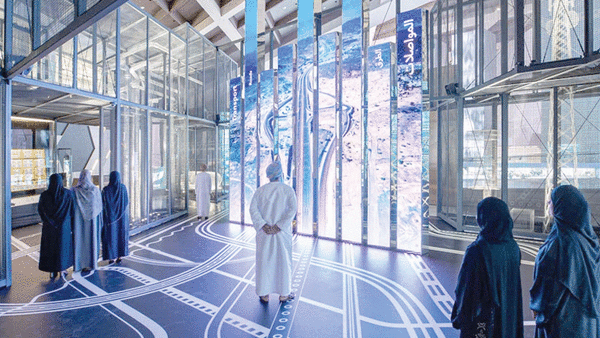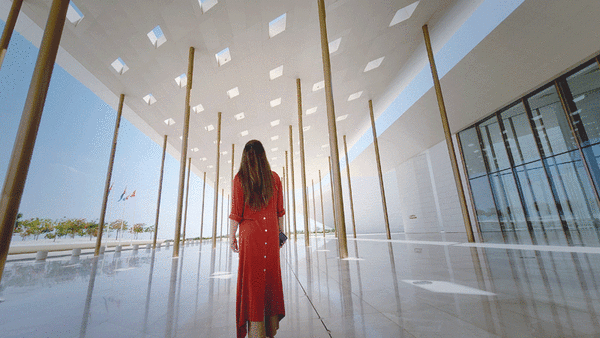

By design, the Oman Across Ages Museum was built to represent many things: the importance of the country’s history, the triumph of Oman from past to present, a subtle summary of Oman’s building policy, and a celebration of its bright future.
It was designed to become an architectural wonder, taking inspiration from the pronounced beauty of the Al Hajar Mountains and boldly representing the Oman environment and its geographical traits while bestowing modern and futuristic characters, all merging so well that the lines between the past and the present are well represented almost in every corner.
With an area of 300,00 sqm and the building being 66,000 sqm wide, it takes hours just to explore the installations from one end to the other.
For those who are curious about its technical parts, it uses steel-coloured glass, four layers of it, about 6 cm thick each, and is about 5 metres high. Its glass facade rises as high as 25 metres, and while its clear silhouette dominates the Manah landscape, its builders have successfully blended it with its surrounding landscape.

To achieve the design intent of a weathered steel appearance, the about 2000 aluminium panels used underwent a process called double anodization. Quoting the report from the experts who worked on the project, Grankraft mentioned, “The different colours on the panels are produced with the electrochemical deposition of metal salts in the pores of the anodizing layer. The aluminium is durable, corrosion-resistant, UV-resistant, and has a life expectancy of over 80 years, without losing gloss or colour.”
While everyone will have the opportunity to gawk at the different halls, pavilions, and displays, only a very few know the best-kept secrets of what makes the museum a true wonder. Eng Al Yaqdhan bin Abdullah al Harthy, Director General of the Museum, was at every step of the museum’s construction.
The late His Majesty Sultan Qaboos laid the foundation stone of the museum in 2015, and within the last eight years, he accomplished some of the most amazing engineering and architectural feats inspired by the traditional building methods in Oman.
“One of the true wonders of the museum will remain unseen by the public,” Al Harthy shared.
“Below the floors of this building is a labyrinth that allows for airflow that helps cool down the building all year round,” he shared.
He said that a specially built tunnel was filled with containers that are naturally frozen by the cooler night temperature, with the stored energy being released later in the form of latent heat to the air supply system to cool the incoming air for the outside air supply.
“The museum was also built for maximum natural light, but not so much that it becomes too bright,” he said.

The museum has a low profile on its eastern side, which shields the inside from direct sunlight during sunrise. On the museum’s western side, the windows are built into sloped walls, which block direct sunlight and lower the energy needed for illumination.
What is most remarkable is that this technique was inspired by the building techniques used for the ancient castles and buildings of Oman, with walls clad by high-quality Omani stones taken from governorates of Al Dhahirah and Al Batinah North that help cool down the surrounding air.
Al Harthy was proud that, regardless of the time of day, the museum offers a comfortable space for its visitors.
WHAT’S INSIDE?
The museum is consists of two halls: the History Hall and the Renaissance Hall.
Once a visitor sets foot inside, they are taken on a journey through the geography and history of Oman; the oldest items in the museum date back to prehistoric eras.
The History Hall consists of a series of pavilions, each dedicated to a particular subject: The Land of Oman, Early Settlers, The Civilisation of Majan, The Kingdom of Majan, Maritime Heritage, Aflaj Irrigation, Embracing Islam, The Al Ya’aruba Dynasty, and The Al Busaidy Dynasty. In this way, visitors can travel through time and space, from the country’s geological formation, through the experiences of the early settlers to the modern Renaissance age.
The History Hall also relates various events to their historical epochs, with two basic features taking prominence: maritime heritage and aflaj (a traditional irrigation system). The geological formation of the Land of Oman and the Stone Age is represented in the Early Settlers pavilion, the Bronze Age is seen through the Civilisation of Majan pavilion; and the Iron Age is represented in the Kingdom of Oman pavilion. The pavilions for different ages exhibit various aspects of daily life. These are evident in the settlements of Ras Al Hamra and Ras Al Jinz and their relationship with seasonal migrations, maritime communication, copper trade, and the construction of the aflaj system.
The pavilions offer a high-definition environment showcasing the contribution of the people of Oman to Islam, in addition to different aspects of intellectual, political, and social life and economic life.
Exhibits are introduced via digital media to create multi-dimensional environments that enable the visitor to experience each era in virtual reality.
Through the use of high-definition audio-visual presentations and virtual maps, the History Hall also explores the eras of the Al Ya’aruba Dynasty and the Al Busaidy Dynasty. This chronicles the period of the state’s establishment, the period of the Omani Empire, the period of division of government between Muscat and Zanzibar, and the period that led to the Renaissance. The emphasis is on aspects of daily life and achievements in various fields of life during the rule of the Imams and sultans of the Al Busaidy Dynasty.
The Renaissance Hall consists of pavilions titled Dawn of the Renaissance, Building A Nation, Our Society, Healthy Environment, Peace and Stability, Towards A Sustainable Economy, Infrastructure and Connectivity, Ash’shura, Oman, and the World, Inspiration, Creative Expression, and Media and Communications.
The hall’s entrance is an open space in the centre of gigantic columns, which form an interactive space with a panoramic view of presentations via a high-resolution audio-visual display system that deals with the years of the Blessed Renaissance. This explores various aspects of the social, economic, industrial, and political transformation experienced by Oman, while at the same time preserving its authentic identity and cultural traditions.
The Hall comprises interactive digital exhibits that display the speeches of His Majesty Sultan Haitham bin Tarik and of the late Sultan Qaboos bin Said. It also explores fundamental aspects of the Blessed Renaissance such as education, healthcare, infrastructure, foreign relations, tourism and the economy.
The Oman Across Ages Museum houses 310 video exhibits and 1,200 interactive, 2D and 3D screens, map projection technology, as well as 1,300 antique exhibits, 80 replica exhibits, 500 text panels and drawings, 150 display boxes, 61 km of fibre-optic cables, and 21 km of audio-video cables.
Notable exhibits in the museum include the jaw of the Omantherium, a type of huge primitive elephant that lived on the land of Oman about 35 million years ago, and trilobites found in the Wilayat of Mahout in the Al Wusta Governorate, which date back to 250 million to 500 million years ago.

The Museum also contains the Majan Ship, which is a reimagining of the vessels of the Majan Civilisation made of reed bundles tied with ropes of palm fibres and woven mats sealed with black tar.
Another notable exhibit is a message from His late Majesty Sultan Qaboos bin Said to his teacher in the month of Rajab 1374 AH, corresponding to February 1955.
The museum includes educational games for children with modern interactive technologies that provide a unique museum experience.
The museum also contains the Knowledge Centre, which is an information resource for students, researchers, and readers. The Centre represents a key feature of the Oman Across Ages Museum and comprises a rich source of information that contributes to building knowledge for all, from children to researchers.
The Centre provides equal opportunities for all to benefit from its facilities, equipment and services, promoting and developing cultural and historical knowledge by providing lifelong learning opportunities via interactive educational programmes, training workshops, lectures and seminars.
The Knowledge Centre, spread over three floors occupies a total area of 6,000 square metres. The ground floor houses the Ideas Lab and the Innovation Lab, which are equipped with tools and books suitable for children from 3 to 14 years old.
The first and second floors house the library of Hisn Al Shumoukh. The library contains more than 46,000 titles in various areas of science and knowledge. It is equipped with technology that allows researchers to access their desired titles and references, in hard copies or electronic form.
The Library provides services in person to visitors or remotely via a digital reference service operating through the Centre’s website, an instant chat service and an “Ask the Librarian” form. Services are also available via email, smartphone applications and social media. The Library’s facilities also include a lecture hall, a multi-purpose hall and facilities for disabled people. The Museum has a shop, which offers a wide range of exclusive gifts with attractive designs, many of which are inspired by the history, heritage and culture of the Sultanate of Oman.
Oman Across Ages Museum is located in the Wilayat of Manah in the heart of the Al Dakhiliyah Governorate.
Oman Observer is now on the WhatsApp channel. Click here



